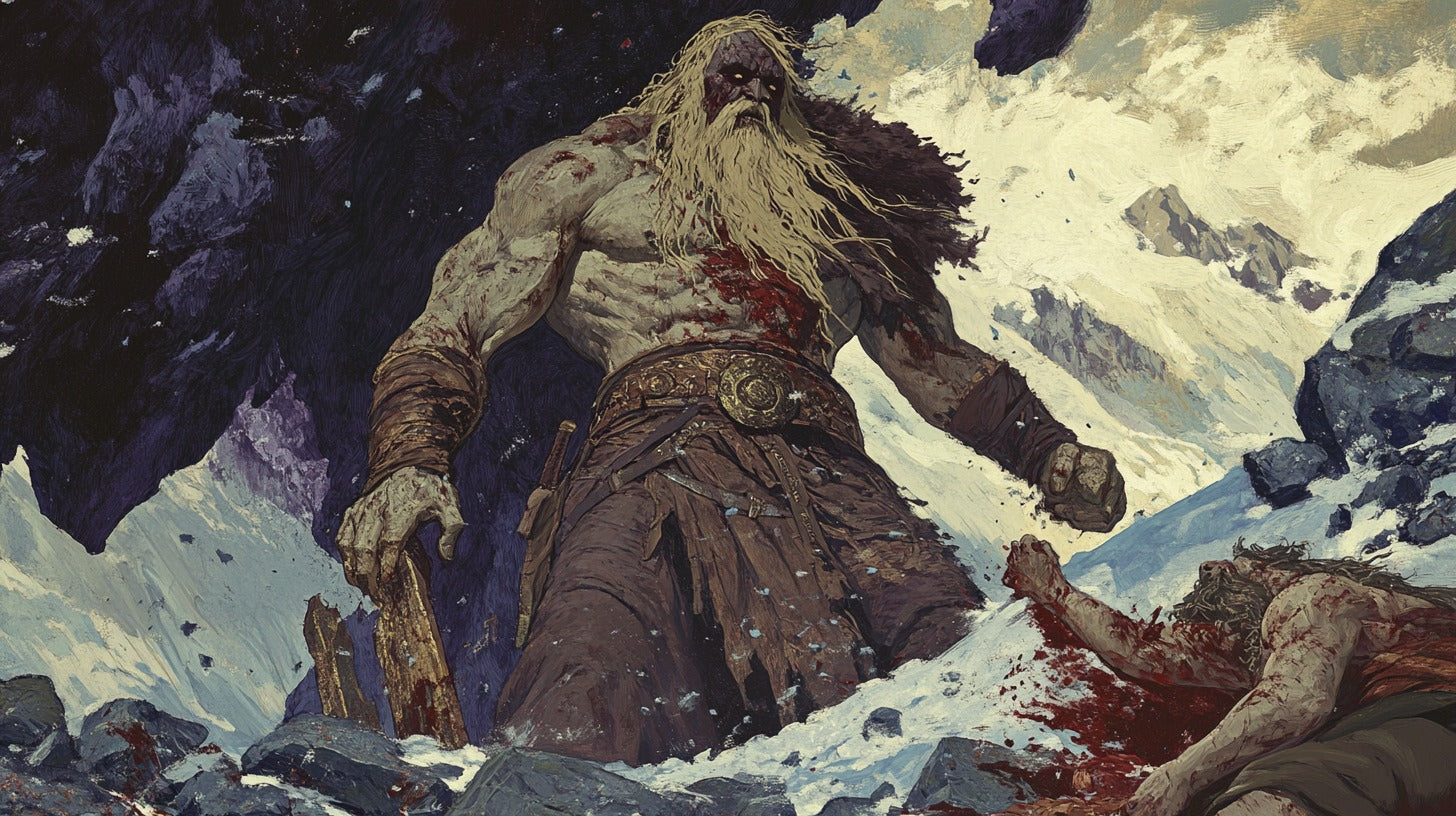
The Makers of Mjölnir: Dwarves in Norse Mythology
Dwarves hold a prominent place in Norse mythology as creators of legendary artifacts, magical beings with unparalleled craftsmanship, and enigmatic figures intertwined with gods and heroes. Their presence in myths reveals a rich tapestry of creativity, magic, and complexity. These beings, often associated with the earth, embody themes of transformation and ingenuity, serving as essential architects of the Norse cosmological framework.
Origins of Dwarves

Four figures with raised arms, carved into the face of the Heysham hogback stone, are believed to represent the mythological dwarfs Norðri, Suðri, Austri, and Vestri, who uphold the heavens in Norse cosmology. (Illustration: Lancashire and Cheshire Antiquarian Society)
The Völuspá, one of the key poems in the Poetic Edda, provides the earliest account of the dwarves’ creation. According to the myth, dwarves were born from the flesh of Ymir, the primordial giant whose body formed the world. Initially described as maggot-like creatures inhabiting the earth, they were later endowed with intelligence by the gods. The myth identifies the first dwarves as Modsognir and Durin, followed by a detailed genealogy listing many more. This origin story highlights their connection to the foundational elements of the Norse cosmos.
Characteristics and Roles

Dwarves are primarily characterized by their exceptional skill in craftsmanship and magic. They are often depicted as short, sturdy beings dwelling in subterranean realms like Svartálfaheimr, though sources sometimes conflate them with dark elves (svartálfar). Their physical appearance varies across accounts, with some emphasizing their grotesque features and others their practical, earthy traits.
The dwarves’ contributions to Norse mythology are immense, including the forging of Thor’s hammer (Mjölnir), Odin’s ring (Draupnir), and Freyr’s ship (Skidbladnir). These objects are not merely tools but symbols of power and divinity, underscoring the dwarves’ role as creators and sustainers of the mythic order. Beyond crafting, dwarves possess deep knowledge of the arcane, often acting as custodians of hidden wisdom.
Key Myths and Stories

The Ribe skull fragment, an 8th-century artifact, features a runic inscription interpreted as a protective charm, possibly warding off one or two dwarfs. (Photo: Lennart Larsen, Nationalmuseet, Danmark, CC BY-SA 4.0)
The mythological canon brims with tales of dwarves shaping the fate of gods and heroes. In one of the most famous stories, the brothers Sindri and Brokkr craft Mjölnir, Thor’s hammer, after Loki wagers his head on their abilities. Another tale recounts the creation of Draupnir, Odin’s golden ring that multiplies itself every ninth night.
Dwarves also appear as antagonists or tricksters, reflecting their multifaceted nature. In the story of Andvari, the dwarf’s cursed treasure triggers a cycle of greed and tragedy, linking him to the famed Volsunga saga. These narratives reveal dwarves as both benefactors and disruptors within Norse mythology.
Etymology and Name Connections

A lead plaque discovered near Fakenham, Norfolk, is thought to be an ancient charm intended to ward off a dwarf. (Photo: Norfolk County Council, CC BY-SA 2.0)
The term "dwarf" derives from the Old Norse dvergr, which shares linguistic roots with terms across the Indo-European language family, such as the Old English dweorg. These words often connote notions of death, the earth, or subterranean realms, reflecting their mythological association with underground living and transformation.
Many dwarf names, listed in Völuspá, bear significant meanings, often linked to attributes like wisdom, craftsmanship, or nature. For example, Alfr implies connections to elves, while Sindri suggests a "spark" or "glow," symbolizing their role in forging and fire.
Parallels in Other Mythologies
The concept of dwarves finds echoes in numerous cultures. In Greek mythology, the Telchines, magical smiths of Rhodes, share similarities in their craftsmanship. Celtic folklore also features diminutive, magical beings like the leprechauns and clurichauns, who blend cunning with artistry. These parallels suggest a shared Indo-European cultural memory of earthbound, magical artisans.
Legacy in Norse Culture

Thor's Hammer Skåne Mjölnir Triquetra Rings
Dwarves’ legacy extends beyond myth into the cultural practices of the Viking Age. Archaeological finds, such as intricately forged jewelry and weapons, reflect the reverence for craftsmanship symbolized by these mythical beings. Their stories have also influenced modern depictions of dwarves in fantasy literature, from Tolkien’s The Hobbit to contemporary media.
Conclusion
Dwarves in Norse mythology embody the union of creativity, magic, and earthbound realism. As legendary smiths, guardians of wisdom, and complex characters, they have left an indelible mark on the mythological and cultural landscape of Scandinavia. Their influence persists in both historical and modern narratives, bridging the ancient and the contemporary.

The Dwarfie Stane, located on the island of Hoy in Orkney, is a large Neolithic sandstone block carved into a tomb. Unlike the typical chambered cairns of the region, its construction resembles Mediterranean rock-cut tombs, making it a unique feature in Orkney's ancient landscape. (Photo: Grovel at English Wikipedia, CC BY 3.0)
FAQs
- What role do dwarves play in Norse mythology?
Dwarves are creators of legendary objects like Mjölnir and Draupnir, and are known for their craftsmanship, magic, and wisdom.
- Where do dwarves live in Norse mythology?
Dwarves typically reside in subterranean realms, such as Svartálfaheimr, often associated with dark elves.
- How were dwarves created in Norse mythology?
According to the Völuspá, dwarves emerged from Ymir’s flesh and were later endowed with intelligence by the gods.
- What are some famous dwarves in Norse myths?
Notable dwarves include Sindri, Brokkr, and Andvari, all known for their craftsmanship and key roles in mythological tales.
- Are dwarves unique to Norse mythology?
While distinct, similar beings appear in other cultures, such as the Telchines in Greek mythology and leprechauns in Celtic folklore.
References
Byock, J.L., 2005. The Prose Edda. Penguin Classics.
Davidson, H.R.E., 1993. Gods and Myths of Northern Europe. Penguin Books.
Lindow, J., 2002. Norse Mythology: A Guide to Gods, Heroes, Rituals, and Beliefs. Oxford University Press.
Orchard, A., 2011. Dictionary of Norse Myth and Legend. Cassell.
Simek, R., 2007. Dictionary of Northern Mythology. Boydell & Brewer.
Tolkien, J.R.R., 1936. Beowulf: The Monsters and the Critics. Clarendon Press.








